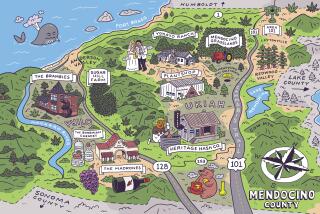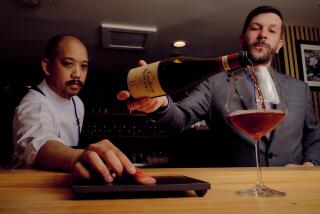The Sweet Life at Far Niente : A Former Oklahoma Nurseryman and Guided-Missile Physicist Makes World-Class Chardonnays and Cabernets in the Napa Valley
THERE IS SOMETHING wistfully charming about both the sound and the meaning of the old Italian phrase, dolce far ni . It has been translated, with poetic freedom, to mean “the good life, sweet, without a care.” Far Niente was already the name of the 60-acre Napa Valley vineyard when John Benson, an uncle of American painter Winslow Homer, bought it in 1870. Benson had the legend carved into the stone face of the three-story winery he built in the 1880s. It had been designed by Hamden W. McIntyre, who also had been responsible for the impressive grandeur of Inglenook, Greystone, Trefethen and Chateau Montelena--Napa Valley landmarks that still endure. When Oklahoma-born Gil Nickel, a commercial nurseryman turned guided-missile physicist, acquired the abandoned shell of the 19th-Century winery in 1979, his stated goal--”to create a world-class American wine estate”--went almost unnoticed. But with the release of his first wine, a vintage Chardonnay of uncommon excellence and obviously expensive packaging, wine lovers at home and abroad kept the wires hot with queries. Who is this Gil Nickel? Where did the money come from? Who is his wine maker?
Now, of course, the story is well known in the best wine circles, and the Far Niente Winery of Oakville is one of the Napa Valley’s most handsome ornaments in the gold-medal league.
Harold Gilliland Nickel and his brother, John, came into vineyard agriculture quite naturally. Their father operated one of the largest wholesale nurseries in the United States, one with highway-landscaping sales in 35 states. Both brothers worked their way through school in the nurseries, their father’s business. But Gil wasn’t sure he wanted to stay in agriculture, and with parental permission he went off to college to earn a degree in physics, working for a while in a guided-missile laboratory. Not particularly fascinated with that endeavor, he went to San Francisco to look into the wine business. The home he found on Nob Hill had a wine cellar and wine-making equipment. He was hooked.
Gil took classes at UC Davis for a year, found Far Niente in 1979 and began its three-year restoration, along the way gaining a 30-year lease on the adjacent Stelling Vineyards. Far Niente, abandoned at the onset of Prohibition, had endured 60 years of neglect. Nickel met the challenge with Vermont slate floors and roof and a wine-aging cave blasted into the rock that formed the back wall of the building. He used state-of-the- art equipment, stainless-steel fermenters and the finest French oak barrels. As in the last century, the grape-reception area was on the top level, so the grapes’ nectar could flow by gravity into the fermenters on the second level and into aging cooperage, barrels, then on down to the first level for bottling and ultimate shipping. Young Dirk Hampson, with apprentice work at Schloss Vollrads in
the Rhineland and Chateau Mouton- Rothschild in Bordeaux, came aboard as Nickel’s assistant. With the 1983 crush, the then 27-year-old was appointed wine maker. Gil and winery proprietor Beth Yorman, also from Oklahoma, have been on the road on behalf of Far Niente Wines, with John Nickel, who was a full partner in the endeavor, sharing production responsibilities.
I’ve been to this wine estate many times, in all seasons of the year, watching the landscaping grow ever more opulent, fulfilling Nickel’s original goal. I’ll confess a happy addiction to Far Niente Chardonnays; I’ve found every successive vintage to be of that world-class quality Nickel demands. Some have felt that the Cabernet Sauvignon doesn’t reach the same high plateau, but I disagree. In the beginning, the 1983 seemed rather light and soft, bringing to mind the general opinion of the first Jordan 1976 Alexander Valley Cabernet, which fooled everybody and is today a collector’s item. The Far Niente 1984 Cabernet Sauvignon (83% Cabernet Sauvignon, 15% Cabernet Franc, 2% Merlot) is ready for release ($25) and, in the winery’s opinion, is their best yet. Frequent re-tastings of the ’83 confirm my early estimation that it, too, will be a palate-caressing wonder.
Last week, in the refurbished Bernard’s at the Biltmore, I took a bottle of the ’84 Cabernet to sample at dinner. My hosts asked if we might compare it with a 1970 Chateau La Fleur Petrus of Pomerol. Extremely rare, $170 on the wine list, who would say no? We were six at the table. The wines were very different, the Far Niente being young and aggressive but already winsomely fragrant, vividly alive and of haunting perfection, The French wine, of a good vintage--just past its peak, I thought--was lovely, but to my taste, tired. Three of us preferred the Far Niente, three preferred the La Fleur Petrus. De gustibus non est disputandum --there’s no accounting for taste.
We concluded our meal at Bernard’s with Nickel and Dirk Hampson’s newest offering, appropriately titled Dolce, a stylish dessert wine in Sauternes tradition. It is two-thirds Semillon and one-third Sauvignon Blanc in the same “noble rot” tradition as Chateau d’Yquem. However, it is much less rich--only 10.9% residual sugar. It married beautifully with a lemon tartlet, but Nickel suggests that it would also be quite regal when served in French haut gourmet style with fresh foie gras . It was produced in limited quantity and sold only at the winery ($30 for 375 milliliters).
More to Read
Sign up for The Wild
We’ll help you find the best places to hike, bike and run, as well as the perfect silent spots for meditation and yoga.
You may occasionally receive promotional content from the Los Angeles Times.






